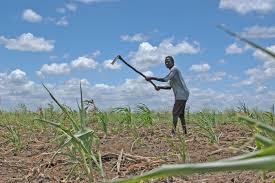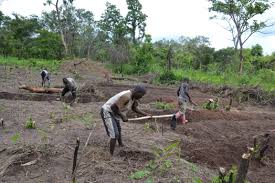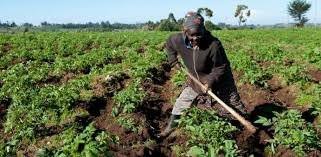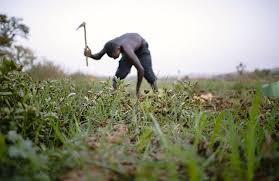In this article, land will be discussed. Issues such as land uses, land tenure systems, and the land use decree will be covered.
Meaning of Land in Agricultural Production
Land could be defined as a farm resource given by nature. Land resources include the following: soil, minerals, forests, fishing grounds (water surfaces), and climates. All resources that exist naturally and contribute to the production of farm output are classified as land.
From the point of view of agriculture, land is the most important factor of production. No agricultural production can take place without land.
Land for the production of crops and rearing of animals is not homogeneous. What can be produced from a particular piece of land depends on several factors namely:
i. the climatic condition of each area, especially rainfall distribution
ii. the nature and fertility of the soil, which explains why in the same area maize does well on some plots of land and performs poorly on others
iii. the topography of the area
iv. cultural practices of the people
v. the quantity and quality of resources applied
vi. the position of the area in relation to the market
Read Also: Unearthing the Impact of Landfills on Our Environment
Major Uses of Land in Agriculture and Beyond

Land can be used for the following agricultural production activities:
1. Crop production: The most important use of land for agricultural purposes is the cultivation of crops. Such crops include food crops, tree crops, fruits, vegetables, and fibre crops.
2. Animal production: Animal rearing requires land for grazing as well as for providing shelter for non-ruminant animals. For grazing purposes, land can be used to produce pasture and forage for feeding livestock. In some places, animals graze on natural pasture.
3. Fishery: Apart from the natural water bodies used for fishing, artificial lakes and ponds are constructed on land for the purpose of rearing fish.
4. Forestry: Large areas of land are used for the establishment of agroforestry. Some areas not suitable for arable crop production can be converted to forest. Generally, forests can be established on poor land or on land under dispute between communities.
5. Wildlife conservation: Many areas of land in Nigeria are reserved for wildlife management. Wildlife conservation is necessary to preserve certain species of wild animals and prevent their extinction.
Non-Agricultural Uses of Land
Apart from agricultural production, land is used for other purposes that may directly or indirectly support farming activities. Some of these uses include:
1. Residential buildings: Land is required for building houses. Expansion of residential areas leads to the development of villages, towns, and cities. Residential buildings occupy a substantial part of agricultural land.
2. Land for industries: With growing populations, more industries are established to meet people’s needs. Each industry occupies a tangible portion of land for its operations.
3. Institutions: Both civil and religious organisations occupy land for schools, churches, mosques, and other institutions across Nigeria.
4. Roads and bridges: Nigeria has a vast network of roads and bridges, including rail lines linking towns and states. These infrastructure facilities occupy millions of hectares of land.
5. Parks and recreational centres: Facilities like amusement parks, football fields, and swimming pools also take up significant land areas.
6. Mining: Mining activities make extensive use of land and often reduce or destroy its value. For example, crude oil spills can render farmland unproductive and create wastelands.
Types of Land Tenure Systems in Nigeria

Land tenure refers to the way land is controlled either temporarily or permanently. The term “tenure” comes from the Latin word tenere, meaning “to hold”.
It involves land held by individuals, groups, or families. Land tenure significantly impacts agriculture in Nigeria and has long been a central agricultural issue. The major types of land tenure systems in Nigeria include:
A. Communal Land Tenure System
In this system, land belongs to a community, not to individuals. The community may be a family, village, or clan. Members are entitled to farm a piece of land, but they do not own it.
Land is not given to strangers and cannot be sold unless the community agrees. Once a plot is allocated, the member may grow any crops but cannot sell the land.
1. Advantages: It ensures every community member has access to land for personal food production.
2. Disadvantages: This system is based on small populations and abundant land. As population increases, farmers struggle to access additional land. It may hinder modern farming since land is not sold to outsiders and cannot be used as loan security.
B. Individual Land Tenure System
This system exists in the form of freehold ownership or rent tenancy.
1. Freehold ownership: Gives full rights to the landowner, including the right to sell or develop the land.
i. Advantages: Offers security and encourages investment in land improvement.
ii. Disadvantages: Farmers without land may not afford to buy or rent land. Fragmentation also occurs when land is divided among many heirs, reducing efficiency for mechanised farming.
2. Tenancy or share rent tenancy: Land is rented from the owner, often with the tenant paying rent or sharing part of the yield.
C. Leasehold Land Tenure System
In leasehold, land is held for a fixed duration under specific agreed conditions. It removes communal control and grants use rights to individuals for the agreed period.
D. Primitive Land Tenure System
This system treats land like free natural resources such as air or water. It is common where land is abundant and has little commercial value. Land is used mainly for shifting cultivation or nomadic grazing and is allocated by tribal chiefs.
E. Tenants at Will of Government
In this system, land is owned by the government, and residents occupy it at the government’s discretion.
F. Land Tenure by Inheritance
Here, land passes from one generation to the next within a family. In Nigeria and West Africa, agricultural land is often inherited within extended families.
Problems:
i. excessive fragmentation into scattered plots, making modern farming difficult
ii. family conflicts during land division
iii. uncertainty about the right to transfer land outside the family
iv. difficulty acquiring land for commercial farming
v. landowners are often unwilling to sell land as it is considered immoral
Read Also: Aspects of Agriculture on Livestock Production
Land Use Decree and Its Implications on Agriculture

The land use decree was enacted on March 28, 1978, by the Federal Military Government. It states:
i. all land in Nigeria belongs to the government
ii. land allocation is vested in state governors
iii. certificates of occupancy are issued by the governor or authorised agents
iv. ownership is limited to ninety-nine years
v. crop production is allotted 500 hectares; grazing is allotted 5,000 hectares
vi. Nigerian adults aged 21 years and above have the right to acquire land
1. Aims of the Land Use Decree
i. Reallocate land to enable large-scale farming
ii. Eliminate disputes and inefficiencies caused by traditional land systems
2. Advantages of the Land Use Decree
i. Allows land acquisition across tribal or state lines
ii. Facilitates large-scale agricultural ventures
iii. Certificates of occupancy can be used to obtain bank loans
3. Disadvantages of the Land Use Decree
i. limits federal government’s ability to acquire land
ii. concentrates land ownership among wealthy individuals
iii. allows governors to revoke land rights prematurely
iv. causes land acquisition delays due to administrative bottlenecks
v. encourages illegal land agreements backdated before the decree
vi. hinders timely project implementation if governors delay certificate approval
Before the Land Use Act, customary laws governed land ownership, inheritance, leases, sales, and transfers. Since its enactment, all such land-related matters are now governed by the decree.
Do you have any questions, suggestions, or contributions? If so, please feel free to use the comment box below to share your thoughts. We also encourage you to kindly share this information with others who might benefit from it. Since we can’t reach everyone at once, we truly appreciate your help in spreading the word. Thank you so much for your support and for sharing!

